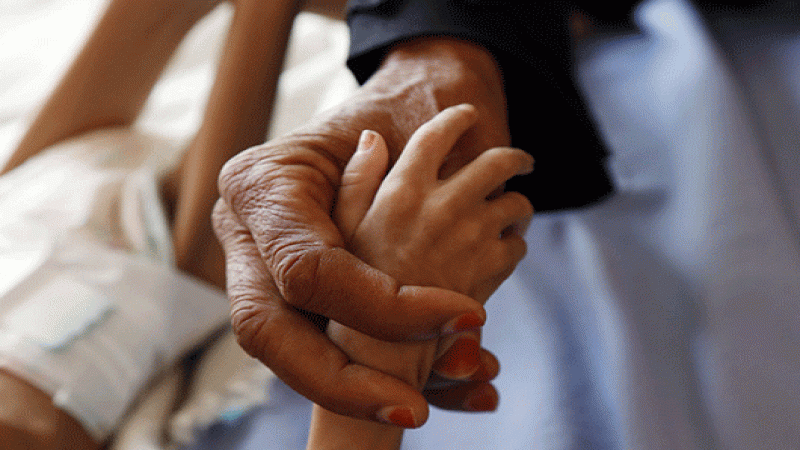
By Jason Lee
Almost 15 months ago to the day I landed in Yemen, home to the biggest humanitarian crisis on the planet. I’ve been an aid worker for more than a decade, deployed to emergencies in places like Afghanistan, Sierra Leone, Zimbabwe and Timor Leste.
But nothing prepared me be for this.
The suffering in Yemen is on a scale that’s hard to fathom.
I recently visited a Save the Children-supported feeding center near the port city of Hodeida, where I met an eight-month-old boy being treated for severe malnutrition. His face was gaunt and his ribs protruding. He was fighting for his life.
The boy’s 18-month-old brother had passed away from a fever not long before.
While I knew well that thousands of children were suffering from malnutrition and stunting across the country, I couldn’t hide my shock when I met the boy, who weighed just 4kg, or about half the average for his age.
I was overcome by a profound sadness. My thoughts immediately went to my 10-month-old niece, the first grandchild for my parents. She is an absolute joy to my family: full of life, vibrant, cheeky and inquisitive. But above all, she is healthy and safe.
I couldn’t help but compare the two children and the lives they were born into.
Despite the impact meeting this young child had on me, his story and situation are far from unique.
Here in Yemen, one child dies every 10 minutes due to malnutrition and preventable illnesses, with an estimated 85,000 children dying since the start of the conflict nearly four years ago.
How much more can the children of Yemen endure?
During the past 15 months, I have seen first hand the hardships that children face – a direct consequence of an avoidable and unnecessary conflict that has engulfed this largely forgotten country, which boasts a population not much more than Australia’s.
I cannot remember another time in my life when I witnessed such desperation and hunger. At the same time, I have also met some of the kindest people imaginable, who welcomed me into their homes despite having barely enough food to survive. Their kindness and resilience was inspiring.
I have also had the privilege of traveling across many parts of Yemen, a beautiful country with rugged mountains, fertile plains and a rich history that dates back thousands of years.
Before the war, Yemen was a bucket-list destination for adventurous travellers. Now it’s one of the most dangerous places on Earth for children.
And the casualties of this senseless conflict go far beyond the physical injuries that children sustain during the fighting and airstrikes, and the emergence of preventable communicable diseases such as cholera and diphtheria, which are made worse by a health system under extraordinary stress.
A generation of Yemeni children have also had their childhoods ripped out from beneath them, losing their access to education.
These children are the future of this country – tomorrow’s teachers, doctors and accountants – but how can they fulfil their potential if they aren’t able to learn to read and write?
And what about the distress, trauma and mental health of children who have witnessed extreme violence and bloodshed? How will children recover once the weapons are finally downed?
For its part, Australia has been a generous humanitarian donor to the Yemen crisis. Its funding has helped begin the enormous task of rebuilding the healthcare system so that women can deliver their babies in functional facilities and access vital medical care and medication.
Save the Children has also used Australian funds to provide children and families with access to clean water and food, and to help prevent the spread of cholera.
Still, it concerns me that Australia has so far been unwilling to disclose details of its military exports to parties to the conflict like Saudi Arabia, who have been accused of committing serious violations of international human rights and humanitarian law against civilians, including children.
The supply of weapons, from some of the richest countries, has helped fuel the war these past four years, elevating the conflict to an even greater level of horror for children.
This simply isn’t good enough, and I urge Australia to ensure its humanitarian funding is not undermined by the issuing of defence export licenses. It should reconsider those that have already been approved, to Saudi Arabia and other parties to the conflict.
Other countries, including Belgium, Norway, Germany and the Netherlands, have ceased or suspended military export licenses to Saudi Arabia.
Despite the unparalleled scale of devastation I see, I am still hopeful.
Just this week the first food aid in six months reached the Tuhayta and Darahimi districts in the south of Hodeida – the main frontline of the conflict. This was possible because of the de-escalation in fighting since peace talks began in December. And while the situation is still fragile and tenuous, it is an improvement.
Whenever I visit communities supported by Australian aid, I am greeted with appreciation that my government, a distant and seemingly utopian country, is extending its help. It is something we should all be proud of.
Though just a sliver right now, the recent peace talks have brought a sense of hope that the conflict could end one day soon, allowing the Yemeni people to begin rebuilding their lives. Then the cries of children will revert back to laughter, and the long recovery process will get under way.
Source: The Guardian, Edited by Website Team